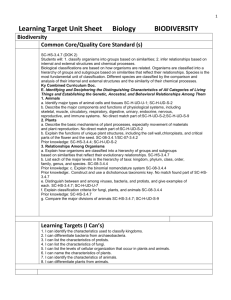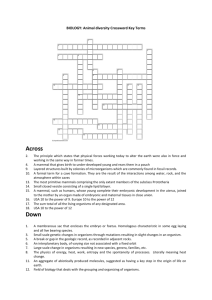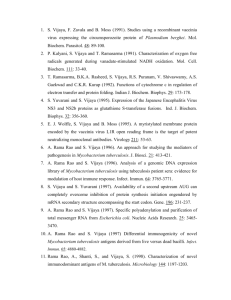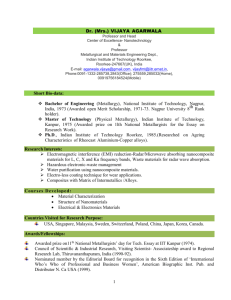Living Organisms and Their Environment
advertisement
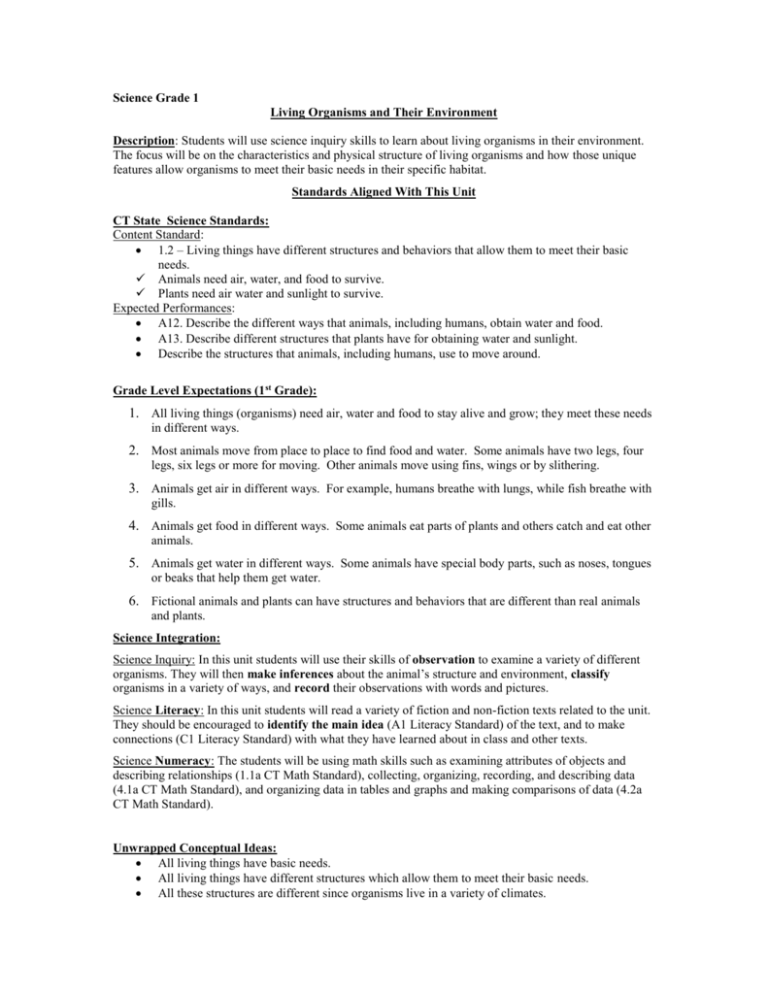
Science Grade 1 Living Organisms and Their Environment Description: Students will use science inquiry skills to learn about living organisms in their environment. The focus will be on the characteristics and physical structure of living organisms and how those unique features allow organisms to meet their basic needs in their specific habitat. Standards Aligned With This Unit CT State Science Standards: Content Standard: 1.2 – Living things have different structures and behaviors that allow them to meet their basic needs. Animals need air, water, and food to survive. Plants need air water and sunlight to survive. Expected Performances: A12. Describe the different ways that animals, including humans, obtain water and food. A13. Describe different structures that plants have for obtaining water and sunlight. Describe the structures that animals, including humans, use to move around. Grade Level Expectations (1 st Grade): 1. All living things (organisms) need air, water and food to stay alive and grow; they meet these needs in different ways. 2. Most animals move from place to place to find food and water. Some animals have two legs, four legs, six legs or more for moving. Other animals move using fins, wings or by slithering. 3. Animals get air in different ways. For example, humans breathe with lungs, while fish breathe with gills. 4. Animals get food in different ways. Some animals eat parts of plants and others catch and eat other animals. 5. Animals get water in different ways. Some animals have special body parts, such as noses, tongues or beaks that help them get water. 6. Fictional animals and plants can have structures and behaviors that are different than real animals and plants. Science Integration: Science Inquiry: In this unit students will use their skills of observation to examine a variety of different organisms. They will then make inferences about the animal’s structure and environment, classify organisms in a variety of ways, and record their observations with words and pictures. Science Literacy: In this unit students will read a variety of fiction and non-fiction texts related to the unit. They should be encouraged to identify the main idea (A1 Literacy Standard) of the text, and to make connections (C1 Literacy Standard) with what they have learned about in class and other texts. Science Numeracy: The students will be using math skills such as examining attributes of objects and describing relationships (1.1a CT Math Standard), collecting, organizing, recording, and describing data (4.1a CT Math Standard), and organizing data in tables and graphs and making comparisons of data (4.2a CT Math Standard). Unwrapped Conceptual Ideas: All living things have basic needs. All living things have different structures which allow them to meet their basic needs. All these structures are different since organisms live in a variety of climates. Unwrapped Major Skills: Students will be able to distinguish between living and non-living things. Students will be able to identify what all organisms need. Students will understand that plants and animals have different structures which help them meet their same basic needs in different environments. Common Misconceptions: Humans are not animals. Plants are not alive. All plants have the same structure. All animals have the same structure. Instructional Strategies That Work: Letting students lead the discussion with the teacher acting as a guide, allowing students to look closely at a variety of realistic pictures (photographs) of animals in many habitats, providing students the opportunity to come up with their own ways to classify and categorize animals and plants. Vocabulary Words: organism, plant, animal, mammal, energy, breathe, lungs, gills, absorb, similarities, differences, structure, characteristics, environment, traits, predator, prey, camouflage, stalk, stem, petals, pollen, reproduce Connections to Literature: From Seed to Plant, Gail Gibbons The Tiny Seed, Eric Carle The Very Hungry Caterpillar, Eric Carle Parts of a Plant, Wiley Blevins Stems, Vijaya Bodach Seeds, Vijaya Bodach Connections to Literature (cont.): Roots, Vijaya Bodach A Trip to the Zoo, Karen Wallace Amazing Animals, Rosario Ortiz Santiago Stellaluna, Janell Cannon A Color of His Own, Leo Leoni Overview of Lessons: Lesson One: Students will identify and classify living and non-living things. Lesson Two: Students will determine the shared characteristics of all living things. Lesson Three: Students will determine similarities and differences between plants and animals, and then use this knowledge to classify them. Lesson Four: Students will become familiar with the different structures common to plants. Lesson Five: Students will learn about the function of different plants structures and how those structures help plants meet their basic needs. Lesson Six: Students will learn about how plants structure and diversity is a result of the different environments in which they grow. Lesson Seven: Students will learn about the different parts of animals and become familiar with the terminology for naming the parts appropriately. Lesson Eight: Students will learn about how animals have different body structures which allow them to move in their habitats. Lesson Nine: Students will learn about how an animal’s coloring allows them to camouflage in their specific environment. Lesson Ten: Students will learn about how an animal’s different structures allow them to find food in their specific environment. Culminating Activity: Students will work with a teacher, paraprofessional, or library media specialist to do a report on a specific animal and it’s relationship with the environment.





